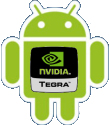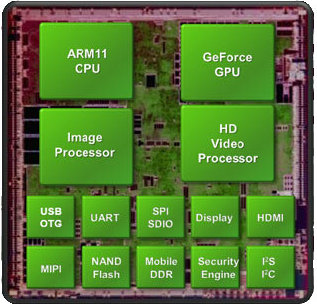Nvidia cops to Android port
Feb 17, 2009 — by Eric Brown — from the LinuxDevices Archive — 1 views Nvidia has confirmed a long-rumored port of Google's Linux-based Android mobile stack to its Tegra series of ARM11-based mobile applications processors. Due in the second quarter, the Tegra port of Android marks the first official Linux support for the Tegra chips, which target smartphones and MIDs.
Nvidia has confirmed a long-rumored port of Google's Linux-based Android mobile stack to its Tegra series of ARM11-based mobile applications processors. Due in the second quarter, the Tegra port of Android marks the first official Linux support for the Tegra chips, which target smartphones and MIDs.
In its brief announcement of the port, Nvidia said it was working with Google and other OHA members on the port. It referenced both “mobile phones” and “handhelds,” but did not detail whether Android would be ported to all chips in its Tegra product family.
In Barcelona this week, the company is demonstrating Android running on a smartphone prototype built around its Tegra APX 2600, which targets phones. Separately, Nvidia announced a reference design for a $100 MID based on the Tegra 600. That design is touted as running Windows CE, but the Android platform appears to be a fairly easy fit for the MID format, as evidenced by Archos's recent announcement of an upcoming MID-like, ARM Cortex-A8-based portable media player (PMP) that runs Android.
Stated Andy Rubin, Google's senior director of mobile platforms, “We welcome NVIDIA's support of Android on Tegra and we look forward to many more Android-based devices that deliver an outstanding consumer experience.”
Stated Michael Rayfield, GM, mobile business unit at Nvidia, “NVIDIA will be working within the Open Handset Alliance to continually strengthen the ability of Android to tap into advanced mobile graphics and media acceleration.”
Tegra goes cross platform
Nvidia's Tegra chips are fairly standard-issue ARM SoCs based on off-the-shelf ARM11 processor cores sourced from ARM, Ltd. The chips distinguish themselves by integrating fairly powerful GeForce GPUs (graphical processor units) supporting higher-resolution screens than are typically found in smartphones. That could make them a good fit for MIDs and even netbooks, although the Nokia- and Archos-led market for ARM-based mobile Linux has arguably already moved up to superscalar (more than one instruction per cycle) ARM cores, with dual-core just around the corner.

Nvidia's Tegra
Touted capabilities of the three Tegra models announced so far, include:
- Tegra APX2500 — 600MHz, 720p HD encode/decode, screens to 854 x 480
- Tegra 600 — 700MHz, 720p HD encode/decode, screens to 1280 x 1024
- Tegra 650 — 800MHz, 720p encode, 1080p decode, displays to 1680 x 1050
Besides their faster clocks and higher-resolution display support, both of the new 600-series Tegra parts boast IDE support, making them suitable for hard disk-equipped devices. Other touted features include:
- Dual displays and HDMI video out
- Internal display can be used for control applications while video plays out over HDMI
- ARM11-based cores support ARM's “MPCore” interconnect technology
- Audio playback of 130 hours, or video playback of 30 hours
Photos of the APX SoCs suggest they are smaller than a dime. The diagram above suggests they integrate an ARM11 core, HD video processor, imaging processor, audio processor, and an ultra-low power GeForce graphics processing unit.
The Tegras' ULP GeForce core has the following touted features and benefits:
- OpenGL for Embedded Systems (OpenGL ES) 2.0 compatibility
- Direct 3D Mobile
- Programmable pixel shader
- Programmable vertex and lighting
- Coverage Sampled Anti-aliasing (CSAA) support
- Advanced 2D graphics
Background
Nvidia is best-known for its GPUs (graphical processor units), graphics cards, and chipsets, all of which target the traditional PC and notebook markets. A year ago, with PC sales down and device sales up, it launched Tegra, a fairly run-of-the-mill line of ARM11-based SoCs representing its initial foray into the world of ARM-based mobile applications processors.
Oddly, when Nvidia launched the Tegra line, it touted support for Windows CE exclusively. The Windows focus continued through June, when Nvidia added the Tegra 600 and 650 models, targeting MIDs (mobile Internet devices). This Windows preoccupation — possibly a carryover from the company's long history in the PC market — even led to a rumor that Microsoft would choose this week's Mobile World Congress show in Barcelona to unveil its own Microsoft branded smartphone based on the Tegra, but so far the phone has yet to appear.
Rumors of Android support have swirled around Tegra all along, however. We noted them in our initial coverage of the APX 2500 smartphone Tegra chip a year ago. Another persistent rumor is that HTC, an early leader among Android phone vendors, will ship a Tegra-based smartphone later this year.
Availability
The Tegra port to Android is scheduled for OEM availability in the second quarter, says Nvidia. The company will be demonstrating the technology at this week's Mobile World Congress in Barcelona, at its booth in Hall 1, Stand IC34.
In other Android-related news this week, VirtualLogix showed a single-chip Android processor design that uses its VLX virtualization software, Freescale announced Android compatibility for its i.MX515 netbook processor, and Huawei announced a new Android phone.
This article was originally published on LinuxDevices.com and has been donated to the open source community by QuinStreet Inc. Please visit LinuxToday.com for up-to-date news and articles about Linux and open source.